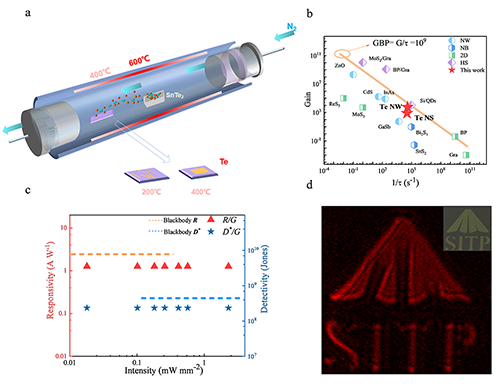| Jun 07, 2021 | |
A new fabrication route for blackbody-sensitive room-temperature infrared photodetectors |
|
| (Nanowerk Spotlight) Blackbody response is an important parameter reflecting the sensitivity of infrared photodetectors and determines the corresponding practical applications. It has been widely applied as one of the standard characterizations for the advanced infrared focal plane array (FPA). | |
| Up to now, most available high-performance infrared photodetectors with blackbody response are based on traditional III-V and II-VI materials such as InGaAs, InSb, and HgCdTe. However, expensive growth methods, such as molecule beam epitaxy (MBE) and metal-organic chemical vapor deposition (MOCVD), and the strict cooling requirements severely limit the wider application and promotion of these traditional infrared detectors. | |
| Relying on the quantum confinement effect, the strong light-matter interaction in low-dimensional materials enables them to exhibit excellent photodetection. The unique out-of-plane van der Waals force in low-dimensional layered materials makes them free from the surface dangling bonds compared to traditional bulk materials, which reduces the dark current of the devices by eliminating surface recombination. | |
| These unique advantages make low-dimensional materials have the potential to achieve breakthroughs in the field of low-cost high-performance room-temperature infrared detection. However, up to now, only a few infrared photodetectors based on quantum dots, carbon tubes, and black phosphorus are reported to have a response to blackbody radiation. The researchers realize that searching for low dimensional infrared detectors with blackbody response is still a huge challenge and needs to be solved urgently. | |
| Now, a research team based at the Shanghai Institute of Technical Physics (SITP) found that CVD-grown Te-based infrared detectors possess a remarkable room-temperature blackbody response. Large-scale, high-quality tellurium nanosheets and nanowires have been successfully prepared by CVD. | |
| The morphology evolution and growth kinetics of low-dimensional Te during the growth process are elaborated by density function theory (DFT). Low-dimensional Te detectors exhibit excellent performance with a large responsivity (R) (6650 A W-1), a high detectivity (D*) (1.23×1012 Jones), and an ultrafast photoresponse (25.5 µs) under the laser illumination. And under 1200 K blackbody source illumination, the R and D* of the Te nanowire devices can reach up to 2.53 A W-1, and 4.68×108 Jones, respectively. | |
 |
|
| Figure 1. a) Growth schematic of low-dimensional Te. b) Gain-bandwidth product (GBP) of low-dimensional photodetectors, exhibiting that the high GBP of low-dimensional Te photodetectors. NW: nanowire, NB: nanobelt, 2D: two-dimensional, HS: hybrid structure. c) Pure responsivity Rp and pure detectivity Dp* versus power intensity under 1550 nm laser illumination. d) Imaging by Te nanosheet photodetectors. (© Science Advances) (click on image to enlarge) | |
| The results have been published in Science Advances ("Blackbody-sensitive room-temperature infrared photodetectors based on low-dimensional tellurium grown by chemical vapor deposition"). | |
| Most importantly, the researchers have clarified the confusing paradox that low-dimensional infrared detectors show high response under laser irradiation but much lower or completely no response under blackbody illumination. And they revealed the physical process that the surface states, as well as the gain, of the low-dimensional infrared detectors, are very high under laser irradiation. While under the blackbody source, the available surface states for lower-energy photon-induced electrons are reduced, leading to a reduction of the gain under blackbody illumination. | |
| Furthermore, high-resolution imaging by the Te photodetectors is obtained and has confirmed that the great potential of Te in practical application fields. The research results provide a new avenue for high-performance blackbody sensitive room-temperature low-dimensional materials infrared photodetectors with an efficient and large-scale fabrication. | |
| Provided by State Key Laboratory of Infrared Physics, Shanghai Institute of Technical Physics, Chinese Academy of Sciences | |
|
Become a Spotlight guest author! Join our large and growing group of guest contributors. Have you just published a scientific paper or have other exciting developments to share with the nanotechnology community? Here is how to publish on nanowerk.com. |
|
